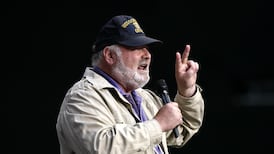From cooling cheese to developing the next generation of the web, mathematics is central to the way we live our lives, writes DICK AHLSTROM, and on these pages over the coming months Prof Peter Lynch of UCD will explore its importance
WHAT TIES together green traffic management, wholesale electricity pricing, the cooling of fresh cheese, drug development and the Higgs boson? The simple answer is maths.
There seem to be remarkably few areas where mathematics is not already being used or where it could make a contribution.
Its centrality to society at large will from today be explored by Prof Peter Lynch of University College Dublin. Twice a month he will contribute articles that will help people realise the importance of mathematics to the sciences and social sciences, technology and medicine.
His introduction and his first report appear today on this page, with subsequent reports appearing on the first and third Thursdays of every month. He hopes to take some of the mystery out of the subject and help people realise why national competency at maths is important for our future.
Mathematics can be used to study and model almost anything, from selling derivatives on the stock market to “watching” the collapse of virtual gigantic black holes. The Mathematics Applications Consortium for Science and Industry (Macsi) at the University of Limerick is involved in this activity, working with scientists just as readily as with industrialists, says James Gleeson, professor of industrial and applied mathematics and co-director of Macsi.
People are usually unaware of the contribution being made by mathematicians, he says. “Mathematics is a language of nature but also of technology, science, economics and social science. You see it everywhere,” he says.
And, while a scientist might immediately see the contribution made by maths, a food production company or a drug developer would seldom think of ringing a mathematician to solve its problems, he says.
Macsi has a varied pool of mathematical research projects underway, such as working with Bank of Ireland to model pricing of a financial instrument called a swaption, or using maths to predict drug release from a stent for Boston Scientific.
Then there is the project with Kerry Co-op to model the cooling of large cheeses, an effort to keep the cheese bacteriologically safe while preventing any flavour loss.
The Hamilton Institute at NUI Maynooth is similarly busy applying advanced mathematics to study the movement of traffic, something that has resonance in data communications.
The institute’s director, Prof Douglas Leith, along with Prof Robert Shorten earlier this month received €1.8 million from Science Foundation Ireland to fund their research, Green Transport and Communications Networks. This partners with Intel and Bell Labs Ireland, looking at ways to model traffic and enable vehicles to co-operate to avoid pollution peaks.
And there is no escaping the Higgs boson, given the recent success recorded by Cern, Europe’s centre for nuclear research. The large collider at Cern can produce a staggering billion particle collisions per second, in turn generating trillions of bits of information, data moved around the world for analysis.
This need was met initially by the worldwide web, created by European physicists as a way to share data but subsequently taken over to produce a global communications network.
The next-generation web is called the grid, and Ireland is a player in this international effort, given that a grid node is based at Trinity College Dublin.
The Grid-Ireland Operations Centre, headed by Dr Brian Coghlan, provides the facilities needed to participate in the handling, transfer and analyse of the huge volume of data coming from Cern.
Mathematical miracles of modern technology
Type a word into Google: a million links come back in a flash. Tap a destination into your satnav: distances, times and highlights of the route appear. Get cash from an ATM, safe from prying eyes. Choose a tune from among thousands squeezed on to a tiny chip. How are these miracles of modern technology possible? What is the common basis underpinning them? Mathematics.
Maths now reaches into every corner of our lives. Our technological world would be impossible without it. Electronic devices such as smartphones and iPods depend on the application of maths. Likewise computers, communications and the internet.
International trade and the financial markets depend critically on secure communications, using encryption methods that spring directly from number theory, once thought to be an area of pure mathematics without "useful" applications.
We are living longer and healthier lives partly because of the application of maths to medical imaging, automatic diagnosis and modelling the cardiovascular system. The pharmaceuticals that cure us and control disease are made possible through applied mathematics.
Agricultural production is more efficient thanks to maths; forensic medicine and crime detection depend on it. Control and operation of air transport would be impossible without maths. Sporting records are broken by studying and modelling performance and designing equipment mathematically. Maths is everywhere.
Galileo is credited with quantifying the study of the physical world, and his philosophy is encapsulated in a frequently quoted aphorism: "The Book of Nature is written in the language of mathematics." This development flourished with Isaac Newton, who unified terrestrial and celestial mechanics in a grand theory of universal gravitation, showing that the behaviour of a projectile such as a cannon ball and the trajectory of the moon are governed by the same dynamics.
Mechanics and astronomy were the first areas to be "mathematicised", but over the past century the influence of quantitative methods has spread.
Statistical analysis now pervades the social sciences. Computers enable us to simulate complex systems and predict their behaviour. Modern weather forecasting is an enormous arithmetical calculation, underpinned by mathematical and physical principles. With the recent untangling of the human genome, mathematical biology is a hot topic.
The mathematics that we learned at school was developed centuries ago, so it is easy to get the idea that maths is static, frozen in the 17th century or fossilised since ancient Greece.
In fact the vast bulk of mathematics has emerged in the past 100 years, and the subject continues to blossom. It is a vibrant and dynamic field of study. The future health of our technological society depends on this continuing development.
When scientific funding is under stress, as at present, cuts are difficult to avoid. There is great pressure on investigators to focus on applications that deliver results quickly.
But experience has shown repeatedly that scientific endeavours impelled by pure curiosity, so-called blue-skies research, frequently yield unanticipated practical benefits. The synergy between pure and applied mathematics is testament to this, and it is important to encourage and support research across the gamut of the subject.
Although a deep understanding of advanced mathematics requires long and intensive study, we can appreciate some of the beauty of maths without detailed technical knowledge, just as we can enjoy music without being performers or composers.
It is a goal of this series of articles to aid in this appreciation. Over the coming months I hope to convince you that mathematics is beautiful, useful and fun.
Peter Lynch









